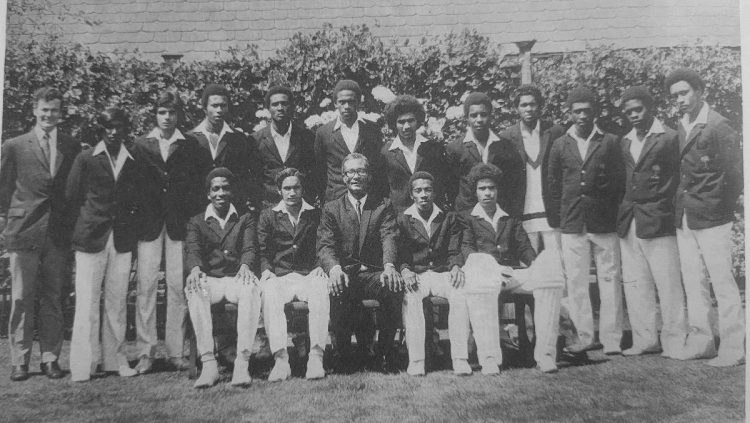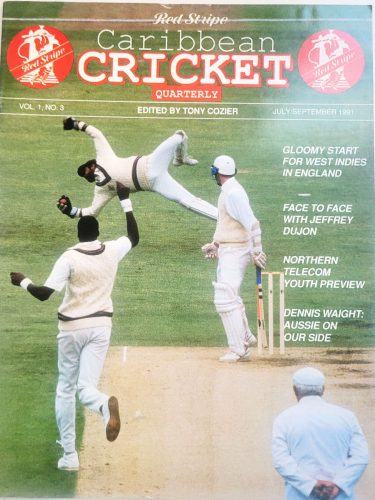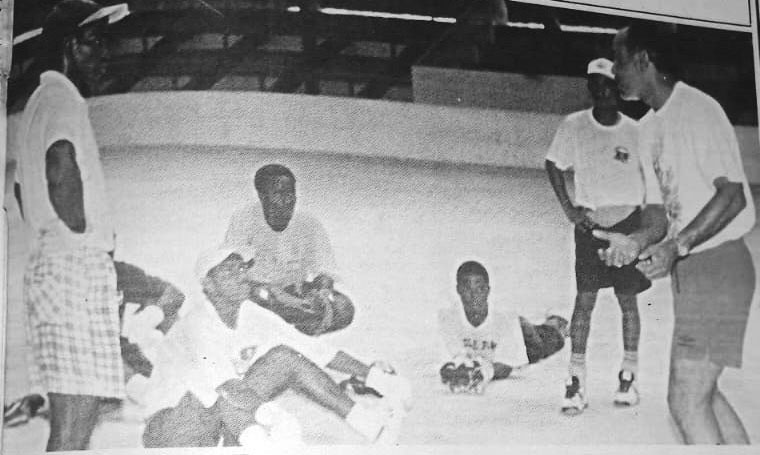This week’s edition of In Search of West Indies Cricket, Part two of three of the ‘Recovered Files: Logie and Dujon’, is an interview Roger Seymour conducted in 1997 with Jeffrey Dujon, the former West Indies wicket-keeper. The notes, which were misplaced in moving, were found a few months ago.
Wicket-keeping Clinic
At the conclusion of the 1997 Northern Telecom (NORTEL) West Indies Youth Cricket Tournament played in Guyana from 9th to 30th August, the WICBC hosted a Wicket-keeper’s Clinic. It was one of the first initiatives by the recently appointed (May, 1997) Director of Coaching for West Indies Cricket Reggie Scarlett (In Search of West Indies Cricket, Dinner with the ‘Scarlett Pimpernel’, 30th April, 2023). Former West Indies wicket- keeper Jeffrey Dujon was selected to oversee the training programme, which was conducted from Monday, 1st September, to Friday, 5th, September.

On Wednesday, the 3rd, I visited one of the sessions at ‘the Gymnasium’, the indoor sports facility on Mandela Avenue. The future of West Indies’ wicket-keeping lay on the floor; glovemen from the NORTEL tournament – Corey Glasgow (Barbados), Carl Wright (Jamaica), Wayne Phillip (Windward Islands), Navin Chan (Trinidad & Tobago), Azib Ali Haniff (Guyana), along with Guyana’s wicket-keeper Vishal Nagamootoo. Dujon, dressed in a t-shirt and shorts, still looking as fit and trim as in his prime, was reviewing the warm-up routine the players had just completed. His delivery was calm, his casual tone firm, but not authoritative.
“Slow jog to warm the blood. Stretching, the key, is from down to up. Hamstrings, very important – 30 seconds each side, rotate three times. Pay attention to each individual muscle group; calf, thigh, hamstring, groin, lower back, upper back, shoulder, neck. Your total time should be about ten minutes. You must warm up before practice, before a match, before an innings. You must have a disciplined approach,” he told them.
“Wicket-keeping requires strength, flexibility and endurance. You must have strong legs for endurance. Twenty-yard wind sprints are essential. Always try to do more. Step ups, skipping, and running in the water at the beach are good for resistance training. When you guys go to the beach to swim, you should also do some running.”
 Dujon was shocked to learn that some of the participants could not swim and never ventured to the beach despite there being a multitude of beaches in all the islands.
Dujon was shocked to learn that some of the participants could not swim and never ventured to the beach despite there being a multitude of beaches in all the islands.
“Everywhere is near in all the islands,” Dujon said in the typical Jamaican matter-of-fact way of speaking. “There’s no excuse.
“Flexibility in the upper body is important for catching. You must have a strong back, you need to develop ‘the engine room’ – abdominals. I do abdominals every day.”
The instructor shared his mantra for personal development and motivation: “Wicket-keeping is hard work but hard work leads to fitness. Fitness gives you confidence. Confidence leads to performance. Performance leads to achievement. Achievement leads to success.”
The agenda shifted to the technical aspect of wicket-keeping – glove work . Over the next hour, Dujon complemented his oral presentation with physical demonstrations. His facility with the language, simple terminology is equally matched by his nimbleness of foot, maintained by his frequent forays on the squash court. The essentials of the art form flow from this fountain of knowledge; a blueprint outlined to the elusive Maroon cap.
Dujon spent significant time on the art of catching. “Focus is the essence of catching. Soft hands are important,” he noted, standing behind a set of stumps installed in a wooden base, as he demonstrated how to gather the ball. Balls flung to him were smoothly taken, nary a sound emanating as the ball vanished into his gloves. He discussed the importance of wearing proper ‘inners’ – the small gloves worn inside the wicket-keeper gloves.
The tips of the trade dispensed included, “Glove work is never too much,” “Head still, stay on your toes, get closer to the ball at all times,” “You are not supposed to make mistakes,” “Avoid bad habits, they are hard to break,” “Spend more time working on your weaker side,” “Practice one-handed catching and short catching,” “When you get tired push harder, “Believe in yourself, anything is possible,” “I’m good, I’ll be better, one day I’ll be the best.”
The NORTEL keepers were all under 19 years of age, while Dujon, 41, had been retired from Test cricket for six years. It was unlikely that these youngsters would have witnessed Dujon, the best wicket-keeper batsman that the West Indies ever had, at his peak. There was the man who had the best seat in the house in the 1980s as the West Indian pace quartet(s) drove opposing teams into retreat. They were sitting at the feet of a master craftsman, who was imparting his wealth of knowledge and experience. No one was taking notes.
As I left, the young charges were executing the supervised drills under Dujon’s keen eye repeating the mantra, “Hard work leads to Fitness, Fitness brings Confidence, Confidence leads to Performance, Performance leads to Achievement, Achievement leads to Success.”
On the morning of Friday September 5th, we met in the upper flat of the Demerara Cricket Club (DCC). It was the final day of the clinic, and Dujon began by offering congratulations on behalf of everyone to Wayne Phillip on his selection for the West Indies A Team Tour to South Africa, scheduled from late November to mid-January. He then reviewed the programme with the participants, and provided handouts for further study and implementation. The final slot was a net session on the hallowed Queenstown pitch, and while the players were practicing, Dujon shared his thoughts on his involvement in the game.
“Age Quod Agis” – Whatever you do, do it well – Wolmer’s School motto
At Cross Roads, Kingston, Jamaica sits the oldest school on the island, Wolmer’s, which was established in 1729. Among its many known legacies was supplying the West Indies Test teams with a line of wicket-keepers, namely, Karl Nunes, Ivan Barrow, Gerry Alexander, and Jackie Hendricks. Young Jeffrey, cricket enthusiast, was well aware of the tradition, and aspired to maintain it. He developed into a technically good wicket-keeper, and became the youngest member of the first West Indies Youth Team to tour England. The following year, he played as a middle-order batsman, as Jamaica won the Benson and Hedges Youth Tournament (commonly referred to as the B & H Tournament). At the age of 18, he donned the gloves and led Jamaica in the B & H Tournament. The legacy was in good hands.
Here are excerpts from the interview with Dujon.
RS: “Let’s start with Wolmer’s. What are your memories?”
JD: “I didn’t like fielding, and all I wanted to do was follow in the footsteps of Jeffrey Mordecai. He was Wolmer’s wicket-keeper, and my mentor (Mordecai is two years older than Dujon). I used to stand back and pay close attention to him. He was a very good wicket- keeper, toured England with the West Indies Youth Team in 1970, then led Jamaica for two years in the B & H tournament. He was a Rhodes Scholar and went off to Oxford and is now a lawyer, didn’t pursue the game.
“At the age of 12, I was playing in the Under-15 team, and by 14, I was in the Under-19 team. From there I was able to emulate Mordecai, succeeding him as wicket-keeper and captain at both levels, as he moved up. I was a prolific scorer at school boy level, getting 15 or 16 centuries in the Sunlight Cup, probably still a record. I set records for the most runs in a season, the best batting average and the most dismissals by a wicket–keeper.”
RS: “You also played with Mordecai at the B & H level?”
JD: “Yes, I played with Jeffrey for two years [1972/73], he kept wicket both years. Then I succeeded him as wicket-keeper for my last two years [1974/75], and led the team in my final year. In the St Lucia tournament [1973], I remember playing against Timur [Mohamed], Faoud [Bacchus] and [Wayne] Daniel.”
(Here is an excerpt from the report of the 1973 B & H Tournament in the 1974 West Indies Cricket Annual, “Jeffrey Dujon made his mark with a beautiful 93 against Guyana as well as deputising as an energetic wicket-keeper against Trinidad.”)
RS: “You were a member of the unbeaten West Indies Youth Team which visited England in the summer of 1974, and made your Shell Shield debut the following year, getting a century off Barbados. Then there was a lull in your career until 1981?”
JD: “I seriously thought about quitting the game after the disappointment of not being selected for the 1978 Tour of India [when most of the first choice Test cricketers were in Australia for Kerry Packer’s World Series Cricket]. I thought I had a good chance as the reserve [wicket-keeper] to David Murray.” (Randy Lyon of Trinidad was selected and hardly played first class cricket after his return to the Caribbean.)
Dujon paused for a moment, and tugged on his Maroon cap, which is emblazoned across the front with the word YAGGA in bold gold lettering.
“In 1981, Lawrence Rowe [former West Indies Test batsman, and ‘Yagga’ to his teammates] was appointed captain of Jamaica, and he insisted to the selectors that if I wasn’t the wicket-keeper he wasn’t going to lead the team. I hadn’t kept wicket for five years, but I always felt it improved my batting. I got a century [107*, batting at seven] in the President’s XI game against England [at Guaracara Park, Trinidad], and another hundred [135*] against Barbados in the Shell Shield. On the basis of those innings I was selected for the West Indies Under-26 1981 [October] Tour to Zimbabwe and the 1981/82 Tour of Australia, and it just went from there.”
RS: “You played as a batsman in the first two Test matches before taking over the wicket-keeping duties in the Third Test at Adelaide. Your first five test innings were four consecutive innings of 40-odd, followed by a 50, and you were instantly very comfortable at that level. How about your wicket-keeping?”
JD: “We had a long line of very good wicket- keepers – Alexander, Hendricks, Deryck Murray and David Murray. David [who was injured for the Third Test with a broken pinky] was excellent. He was very, very good. It was an attack of four fast bowlers and I was standing back all the time. I have always felt very confident standing back, and it was just a matter of time getting used to the varying styles of the bowlers. Initially, I had to depend on my instinct.”
RS: “You took many spectacular catches in your Test career, do any stand out in your memory?”
JD: “Mike Atherton off Curtly Ambrose, diving one-handed catch to my right, second innings, First Test vs England, at Leeds, 1991. Graham Gooch off Patrick Patterson, down the legside, second innings, First Test vs England, at Trent Bridge, 1988. Asif Mujtaba off Courtney Walsh, high to my left, there were no slips, would have been above 2nd slip’s head, second innings, Third Test vs Pakistan, at Karachi, 1986.”
RS: “You missed only one Test behind the stumps due to an injury between 1982 and 1991. [Apart from that one Test – against England at Port-of-Spain, 1986, dating back to the Second Test versus Australia in 1973 at Kensington Oval, to the culmination of Dujon’s career in 1991, the West Indies only utilised three wicket-keepers, Deryck and David Murray, and Dujon.] Since your retirement the West Indies wicket-keeping position has become one of musical chairs between David Williams, Junior Murray and Courtney Browne. Your thoughts?”
JD: “I’m the problem. They are looking for another me, and they ain’t going to find another me. They are wicket-keepers who can bat a bit. I’m a batsman who can keep a bit.” (laughter)
RS: “Parting words?”
JD: “I really enjoyed playing at home and the support we received from the West Indian public. I hope they continue to support the team, it is an integral part of our culture.”
Notes
At the time of his retirement in 1991, Dujon was number two on the list of most dismissals in a Test career by wicket-keepers. His 270 dismissals (265 catches & 5 stumpings) in 81 Tests, were bested by Australian’s Rod Marsh’s 355 victims (343 catches & 12 stumpings) in 96 Tests. Marsh is currently fourth, with Dujon seventh.




